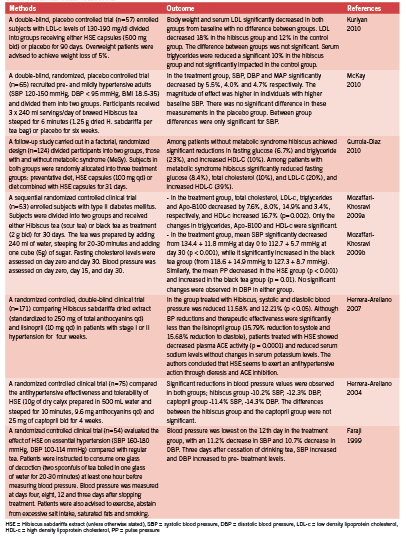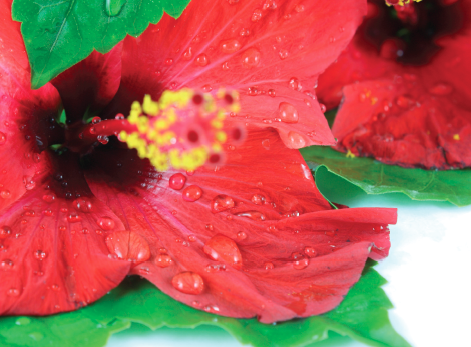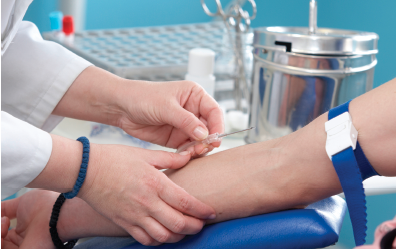Hibiscus
An emerging new botanical medicine
The Hibiscus genus (family Malvaceae) is comprised of several species, many of which have been used historically for their culinary and medicinal properties. The species Hibiscus sabdariffa is an important medicinal plant grown in Africa, the Middle East, South East Asia and Central America (Ojeda 2010). Traditionally, the aqueous extract of H. sabdariffa, colloquially known as sour tea, has been used to treat hypertension, liver disease and fever (Mozaffari-Khosravi 2009).
More recently, the anti-oxidant, lipid and blood pressure lowering effects of Hibiscus sabdariffa have been investigated. H. sabdariffa extracts have demonstrated anti-oxidant properties, hypolipidemic effects, ACE inhibition and inhibition of vascular smooth muscle cell proliferation and migration secondary to hyperglycemia (Huang 2009, Kao 2009, Ojeda 2010, Yang 2010). Considering its nutritional profile, pharmacological properties and safety, H. sabdariffa shows promise as a cardio-protective agent and potential diabetic therapy (Mozaffari- Khosravi 2009).
Chemistry
H. sabdariffa contains various phytochemicals, including phenolics, organic acids, sterols, terpenoids, polysaccharides and some minerals (Ojeda 2010). The phenolic content is composed mainly of anthocyanins delphinidin-3-O-sambubioside (85%) and cyanindin-3-O-sambubioside, plant pigments that are isolated from dried calyces (Frank 2005). Anthocyanins, a subgroup of flavonoids, are water-soluble glycosides and acylglycosides of anthocyanidins (Frank 2005). Other phenols include protocatechuic acid, catechin, gallocatechins, caffeic acid and gallocatechin gallates (Yang 2010).
An aqueous extract of H. sabdariffa (HSE) contains varying concentrations of anthocyanins and polyphenols depending on the processing method and storage time (Frank 2005). Regardless, HSEs contain effective antioxidants, radical scavengers and ferric-reducing compounds, the properties which likely impart their therapeutic benefit (Frank 2005).
Preclinical evidence
Anti-oxidant Effects
Oxidation of low-density lipoprotein (oxLDL) occurs in the early stages of atherosclerotic lesion formation. Scavenger receptors have been identified that bind and internalize oxLDL, mediating its uptake into macrophages and leading to the formation of macrophage-derived foam cells. CD36 has been identified as the predominant scavenger receptor for oxidized LDL and its regulation plays an essential role in the formation of macrophage foam cells and atherosclerosis (Kao 2009).
The most recent study investigating the anti-oxidant activity of H. sabdariffa and LDL oxidation was completed by Kao et al (2009). Hibiscus anthocyanin-rich extracts (HAs) prevented lipid accumulation, significantly decreased CD36 mRNA gene and protein expression and significantly decreased PPARγ protein levels, the CD36 upstream transcription factor, in mouse cells treated with oxidized LDL. The study demonstrated that the antioxidant activity of HAs may ultimately inhibit the formation of oxLDL-foam cells.
Hypolidemic Effects
The hypolipidemic effect of a Hibiscus sabdariffa 74% polyphenol extract (HPE), composed mostly of protocatechuic acid (PCA), caffeic acid and gallocatechin gallate (GCG) were investigated in an animal model (Yang 2010). Hamsters were fed a high fat diet for 10 weeks with or without HSE or HPE; both HSE and HPE fed hamsters experienced a decrease in serum triglycerides and total cholesterol in a dose-dependent manner. However, the HPE had a greater effect on decreasing plasma and LDL cholesterol and increasing HDL than a crude extract (HSE) containing only 2% polyphenols.
At 0.5 mg/mL, HPE decreased fatty acid synthase and HMG-CoA reductase 75% and 69% respectively. The HSE did not alter the protein expression of fatty acid synthase, but rather altered the phosphorylation of AMP-activated protein kinase (AMPK). Previous reports have outlined the importance of AMPK in regulating lipid metabolism; activation (phosphorylation) of AMPK simultaneously inhibits fatty acid and cholesterol synthesis in rat hepatocytes by inactivating the acetyl CoA carboxylase and HMG CoA reductase, respectively (Yang 2010).
In addition the activation of AMPK by HPE decreased the expression of sterol regulatory element binding protein (SREBP), a membrane bound transcription factor which regulates lipid metabolism, and the transcription of its target genes, HMG CoA reductase and fatty acid synthase. Further investigation revealed that HPE also enhances the expression of the LDL-receptor, increasing LDL uptake and hepatic clearance (Yang 2010).
ACE-Inhibition Effects
The inhibition of angiotensin I converting enzyme (ACE) by H. sabdariffa has been demonstrated in vitro with a crude hydroethanol extract from the plant calyces (Ojeda 2010). Using an aqueous extract of H. sabdariffa, delphinidin-3-O-sambubioside and cyanidin-3-O-sambuioside were identified as the two most abundant anthocyanins. Evaluation of in vitro ACE inhibition was completed by quantifying the hydrolysis of N-[3-(2-furyl) acryloyl]-L-phenylalanylglycylglycine (FAPGG) by ACE, both of which were isolated from rabbit lung. A combined anthocyanin-rich fraction, as well as isolated extracts of each anthocyanin were used to inhibit ACE activity in a dose-dependent manner. Both anthocyanins were more effective on their own than the combined extract, and delphinidin-3-O-sambubioside was more effective than cyanidin-3-O-sambubioside, likely owing to the fact that it has more hydroxyl groups. Kinetic analysis suggested ACE was inhibited by the anthocyanins via competition for the enzyme’s active site, most likely due to the rigid planar structure of the anthocyanins and the presence of ortho-dihydroxylation on the aromatic ring.
Inhibition of Vascular Smooth Muscle Cell Proliferation In hyperglycemia of metabolic syndrome or diabetes mellitus, high-glucose conditions mediate the growth and extracellular matrix (ECM) gene expression of vascular smooth muscle cells (VSMC) to promote anti-apoptotic signalling, chemotaxis and migration. Hyperglycemia also promotes the formation of advanced glycation end (AGE) products, which is believed to play a role in atherosclerotic plaque formation when they interact with their specific receptor (Receptor for Advanced Glycation End Products- RAGE) (Huang 2009).
A polyphenolic extract of H. sabdariffa was examined for its protective activity against high-glucose-treated VSMC. The extract reduced the high-glucose-stimulated cell proliferation and migration in a dose and time dependent manner (Huang 2009). Proliferating cell nuclear antigen (PCNA), a marker of proliferation, and activation of matrix metalloproteinase (MMMP)-2, the ECM-degrading enzyme during the process of migration, were suppressed by treatment with the H. sabdariffa extract. Furthermore, expression of connective tissue growth factor (CTGF) and RAGE, usually enhanced by hyperglycemia, were also suppressed by treatment with the extract.
Pharmacology
In a study examining the pharmacokinetics of monomeric anthocyanins after consumption of H. sabdariffa extracts, the anthocyanins were incorporated and excreted in urine in their intact glycosidic forms. 147.4 mg of total anthocyanins were administered to six healthy subjects and maximum excretion rates occurred at 1.5-2.0 hours after ingestion. While oral absorption of H. sabdariffa anthocyanins was fast, maximum plasma concentrations were low, between 1.3-3.4 ng/ml. Peak plasma concentrations occurred almost simultaneously as urinary excretion rates, with maximum excretion rates occurring at 1.5-2.0 hours after ingestion (Frank 2005).
Some evidence suggests that deglycosylation is the rate-limiting step for the absorption of dietary flavonoid glycosides in the small intestine. β-glucosidases, lactase-phlorizin hydrolase (LPH), and the cytosolic β-glucosidase (CBG) are found in the epithelial cells of the small intestine and normally function to deglycosylate flavonoid glycosides during passage across the gut wall (Nemeth 2003). Anthocyanins are not substrates for these β-glucosidases and this may explain the low bioavailability of these compounds, as they were not hydrolyzed to their aglycones and were absorbed only as intact glycosides in small amounts (Frank 2005). However, it is known that most polyphenols ingested from flavonoid-rich beverages are metabolised in the colon (Rechner 2002).

The half-life of total anthocyanins from the H. sabdariffa extract was derived from urinary excretion and was determined to be 2.63 hours (Frank 2005). In a separate study, H. sabdariffa calyx extracts demonstrated a very low degree of toxicity, with an LD50 above 5000 mg/kg in rats (Onyenekwe 1999). Further studies are needed on human plasma and urinary intact glycosides and their in vivo metabolites and/or conjugates in order to fully characterize the pharmacokinetics of H. sabdariffa (Frank 2005).
Human evidence We identified seven controlled human clinical trials evaluating hibiscus preparations. See Table 1. Five of the trials evaluated impact on blood pressure, three trials evaluated impact on serum lipid profiles, and one trial evaluated impact on plasma glucose levels. Only one trial failed to demonstrate a positive outcome; the trial evaluated impact to cholesterol levels and was compounded by recommendations to achieve reductions in body weight. Therefore both the hibiscus group and the control group experienced significant improvement in cholesterol profiles, with no significant difference between the two groups (Kuriyan 2010).
All five trials evaluating blood pressure demonstrated significant benefit, with a magnitude of effect ranging from 5-15% for reductions to systole and diastole (Faraji 1999, Herrera-Arellano 2007, Herrera-Arellano 2004, Mozaffari-Khosravi 2009b, McKay 2010). The two trials demonstrating positive impact to cholesterol levels revealed reductions in total cholesterol, LDL- cholesterol and triglyceride, as well as increased HDL-C levels (Gurrola-Diaz 2010, Mozaffari-Khosravi 2009a). The only trial to evaluate glucose levels likewise demonstrated significant improvement to glucose control (Gurrola- Diaz 2010).
Discussion Hibiscus, delivered in an array of dosage forms (standardized extracts, teas, decoctions), has demonstrated an impressive magnitude of benefit to key metabolic abnormalities, notably the constellation of abnormalities comprising the diagnostic criteria of the metabolic syndrome; glucose control, blood pressure, and plasma cholesterol levels, specifically triglyceride and HDL- cholesterol (as defined by Grundy 2004). The ease of delivery, the marginal cost of the medicine (especially in tea or decoction dosage forms), and an impressive safety profile make hibiscus a promising medicine for an array of very common clinical presentations. Longer- term trials are needed to determine if the effects of hibiscus are sustained beyond 30 days. Also, impact to blood glucose control deserves more research attention.
References:
Faraji MH, Tarkhani AHH. The effect of sour tea (Hibiscus sabdariffa) on essential hypertension. J Ethnopharmacol. 1999 Jun;65(3):231-6.
Frank T, Janben M, Netzel M, Strab G, Kler A, Kriesl E, Bitsch I. Pharmacokinetics of anthocyanidin-3-glycosides following consumption of Hibiscus sabdariffa L. extract. J Clin Pharmacol 2005 Feb;45(2):203-10.
Gurrola-Diaz CM, Garcia-Lopez PM, Sanchez-Enriquez S, Troyo-Sanroman R, Andrade-Gonzalex I, Gomez-Leyva JF. Effects of Hibiscus sabdariffa extract powder and prevention treatment (diet) on the lipid profiles of patients with metabolic syndrome (MeSy). Phytomedicine 2010 Jun;17(7):500-5.
Grundy SM, Brewer HB Jr, Cleeman JI, Smith SC Jr, Lenfant C. American Heart Association; National Heart, Lung, and Blood Institute. Definition of metabolic syndrome: Report of the National Heart, Lung, and Blood Institute/American Heart Association conference on scientific issues related to definition. Circulation. 2004 Jan 27;109(3):433-8.
Herrera-Arellano A, Flores-Romero S, Chavez-Soto MA, Tortoiello J. Effectiveness and tolerability of a standardized extract from Hibiscus sabdariffa in patients with mild to moderate hypertension: a controlled and randomized clinical trial. Phytomedicine 2004 Jul;11(5):375-82.
Herrera-Arellano A, Miranda-Sanchez J, Avila-Castro P, Herrera-Alvarez S, Jimenez-Ferrer JE, Zamilpa A, Roman-Ramos R, Ponce-Monter H, Tortoriello J. Clinical effects produced by a standardized herbal medicinal product of Hibiscus sabdariffa on patients with hypertension. A randomized, double-blind, lisinopril-controlled clinical trial. Planta Med 2007 Jan; 73(1): 6-12.
Huang CN, Chan KC, Lin WT, Su SL, Wang CJ, Peng CH. Hibiscus sabdariffa inhibits vascular smooth muscle cell proliferation and migration induced by high glucose – a mechanism involves connective tissue growth factor signals. J Agric Food Chem 2009 Apr 22;57(8):3073-9.
Kao ES, Tseng TH, Lee HJ, Chan KC, Wang CJ. Anthocyanin extracted from Hibiscus attenuate oxidized LDL-mediated foam cell formation involving regulation of CD36 gene. Chem Biol Interact 2009 May 15;179(2-3):212-8.
Kuriyan R, Kumar DR, R R, Kurpad AV. An evaluation of the hypolipidemic effect of an extract of Hibiscus Sabdariffa leaves in hyperlipidemic Indians: a double blind, placebo controlled trial. BMC Complement Altern Med. 2010 Jun 17;10:27.
McKay DL, Oliver Chen CY, Saltzman E, Blumberg JB. Hibiscus sabdariffa L. tea (Tisane) lowers blood pressure in prehypertensive and mildly hypertensive adults. J Nutr 2010 Feb;140(2):298-303.
Mozaffari-Khosravi H, Jalali-Khanabadi BA, Afkhami-Ardekani M, Fatehi F. Effects of sour tea (Hibiscus sabdariffa) on lipid profile and lipoproteins in patients with type II diabetes. J Altern Complement Med 2009a Aug;15(8):899-903.
Mozaffari-Khosravi H, Jalali-Khanabadi BA, Afkhami-Ardekani M, Fatehi F, Noori-Shadkam M. The effects of sour tea (Hibiscus sabdariffa) on hypertension in patients with type II diabetes. J Hum Hypertens 2009b Jan;23(1):48-54.
Nemeth K, Plumb GW, Berrin JG, Juge N, Jacob R, Naim HY, Williamson G, Swallow DM, Kroon PA. Deglycosylation by small intestinal epithelial cell beta-glucosidases is a critical step in the absorption and metabolism of dietary flavonoid glycosides in humans. Eur J Nutr. 2003 Jan;42(1):29-42.
Ojeda D, Jimenez-Ferrer E, Zamilpa A, Herrera-Arellano A, Tortoriello J, Alvarez L. Inhibition of angiotensin converting enzyme (ACE) activity by the anthocyanins delphinidin- and cyaniding-3-O-sambubiosides from Hibiscus sabdariffa. J Ethnopharmacol 2010 Jan 8;127(1):7-10.
Onyenekwe PC, Ajani EO, Ameh DA, Gamammiel KS. Antihypertensive effect of roselle (Hibiscus sabdariffa) calyx infusion in spontaneously hypertensive rats and a comparison of its toxicity with that in Wistar rats. Cell Biochem Func 1999 17: 199–206.
Rechner AR, Kuhnle G, Hu H, Roedig-Penman S, van den Braak MH, Moore KP, Rice-Evans CA. The metabolism of dietary polyphenols and the relevance to circulating levels of conjugated metabolites. Free Radic Res. 2002 Nov;36(11):1229-41.
Yang MY, Peng CH, Chan KC, Yang YS, Huang CN, Wang CJ. The hypolipidemic effect of Hibiscus sabdariffa polyphenols via inhibiting lipogenesis and promoting hepatic lipid clearance. J Agric Food Chem 2010 Jan 27;58(2):850-9.










